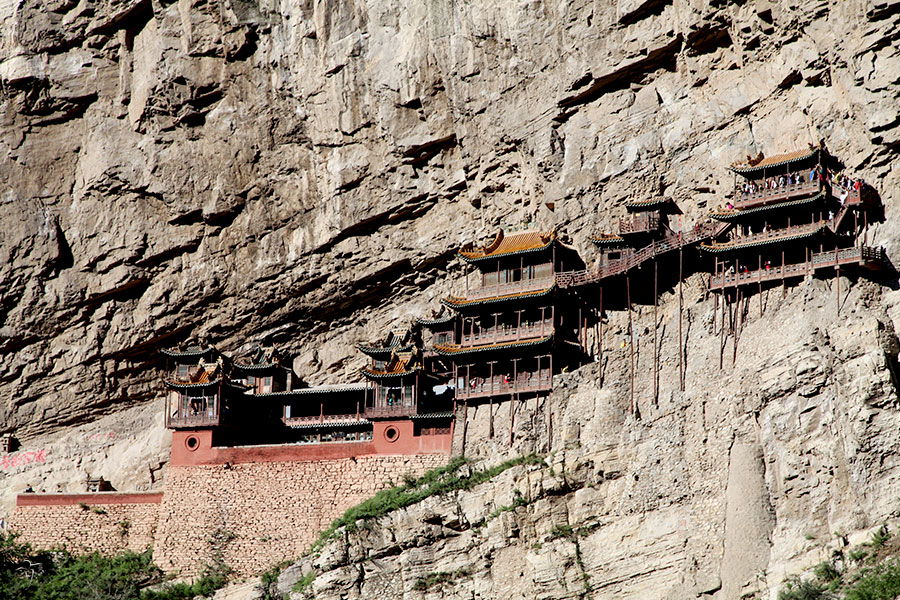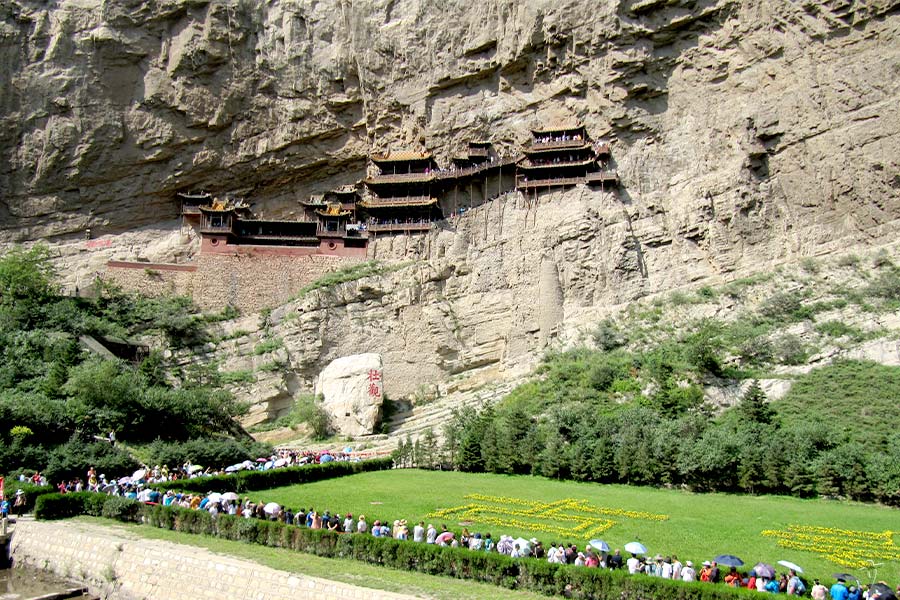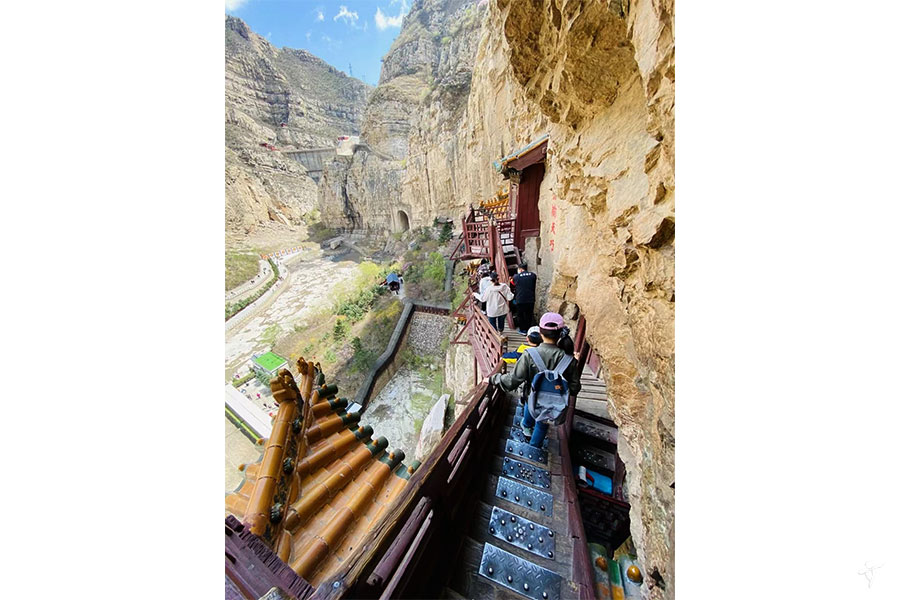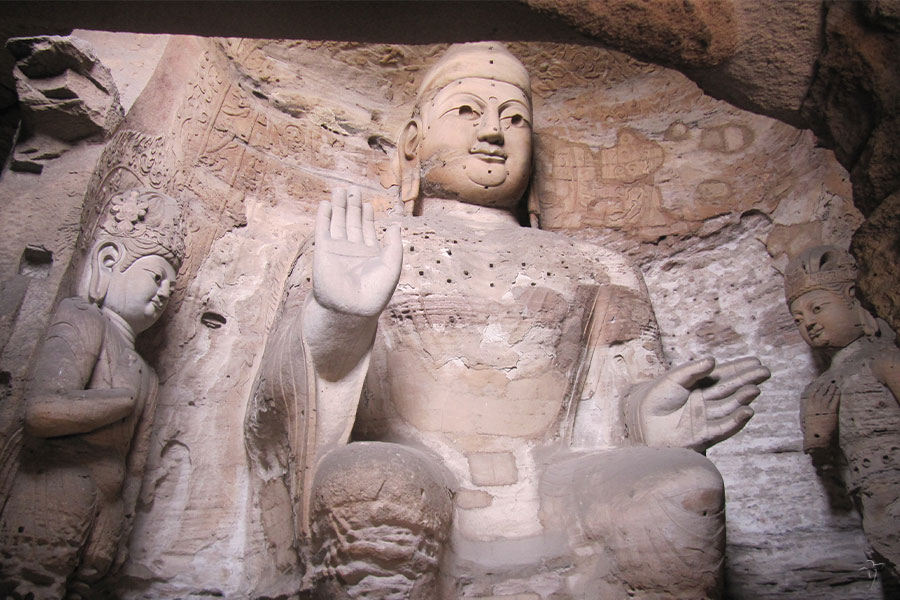Hanging Monastery

Chinese name: 悬空寺 (Xuankong Si).
Location: in Mt. Hengshan, Hunyuan County, about 62 kilometers south of Datong City, Shanxi Province.
Opening time: 08:00-18:00 (in summer); 8:30-17:30 (inwinter).
Ticket: CNY130 in peak season; CNY120 in off season.
How to get there: take a coach from Datong City to Hunyuan County; then take a taxi to Mt. Hengshan Scenic Spot.
Best time for visit: April-October.
Introduction to Hanging Monastery
Hanging Monastery, also called Xuankong Si (玄空寺) in Chinese, stands on the half cliff of the west side of Cuiping Peak (翠屏峰) Of Mt. Hehngshan. It is about 50 meters above the ground and that's the reason for the name. Hanging Monastery was built in 491 during Northern Wei Dynasty (386-534) and has survived for more than 1400 years. The extant monastery was largely rebuilt and maintained in the Ming Dynasty (1368-1644) and Qing Dynasty (1644-1911). In 1982, Hanging Monastery was listed as a National Cultural Heritage of China.
Hanging Monastery is an architectural wonder. A unique mechanical theory was applied to build the framework. Different from the monasteries in plain and mountain areas, the monastery ingeniously took advantage of the original shape of cliff, using the rocks in back as its support. Besides, abundances of crossbeams were semi-inserted into the rock as the foundation. The highest point of the monastery was about 90 meters above the ground at the first beginning, however, the highest point now is only some 58 meters.
Why was Hanging Monastery built against the cliff?
No historical materials record the reason why the monastery was built against the cliff, but it seems that some folk tales can give reasonable explanations to that. One statement consider that the monastery was built in accordance with the principle of Taoism, that is, keeping away from noises "on the earth" (punningly); however another idea supposes that the location was chosen in consideration of protecting the monastery from floods, and the eave-like cliff is just like a natural umbrella. No matter what the real seasons are, we cannot deny that it is indeed a masterpiece in architecture.
One of the Most Spectacular Constructions in the World
As the first attraction of eighteen scenic spots in Mt. Hengshan, Hanging Monastery attracts the tourists from all over the world because of its unique architectural style, which shows the incredible wisdom of ancient Chinese people. In October of 2010, it was selected as one of the "ten most precipitous structures in the world" by TIME, together with the Leaning Tower in Italy and other well-known ones.

Features of Hanging Monastery
The features of the monastery can be concluded to be three Chinese characters:
"奇" (unique) indicates Hanging Monastery is quite unusual with other monasteries not only because of its architectural style but also for its unique location. The monastery leans against the steep cliff and stands on the wooden crossbeams, appearing to be a tumble-down castle in the air.
"悬" (hanging and dangerous) has two meanings in Chinese. One is the literal meaning of "Hanging Monastery", describing this monastery is hung on the cliff. On the other hand, this Chinese character also means "insecure" and "dangerous". It is said that there were not any crossbeams under it when this monastery at the very beginning. The monastery was about 90 meters above the ground at that time. People were afraid of stepping onto this monastery, so some large crossbeams were set into the cliff later as the support of the monastery.
"巧" (ingenious) reflects the architectural design of the monastery.

Unique Religious and Cultural Significance
In addition to its unusual architectural features, Hanging Monastery is also of great significance in religion and culture.
Hanging Monastery is the only preserved monastery blended with Buddhism, Taoism and Confucianism. It is rare to see the sculptures of Sakyamuni, Confucius and Laozi together at a same temple in China. Due to this reason, the monastery has been well protected by the later rulers. The monastery has 40 halls and cabinets, in which about 80 sculptures made of copper, iron, terracotta and stone are enshrined and worshiped. Two steles of more than 800 years are set on the surface of the monastery.
The inscriptions on the steles respectively describe the different background of the three founders and praise their great contribution. Today, some Christian scholars even believe that two Buddha statues of Hanging Monastery are actually from Catholicism, showing the human power of the God and God's return to the world. Therefore, it can be concluded that the integration of these religions probably happened as early as in the Northern Wei Dynasty.
Hanging Monastery has always been a popular toruist destination of ancient literati. In 735, famous Chinese poet Li Bai wrote down two Chinese characters "壮观" (means spectacular) on the rock below the monastery. The renowned traveler Xu Xiake had also come to visit and regarded it as "marvelous in the world".
Quick Questions
Our team is waiting for your questions. Please feel free to ask us any questions you might have about our China package tours, Chinese culture, or the sites available. We will gladly help you with any special needs you might have and all questions, like our trip designing is completely free of charge.





